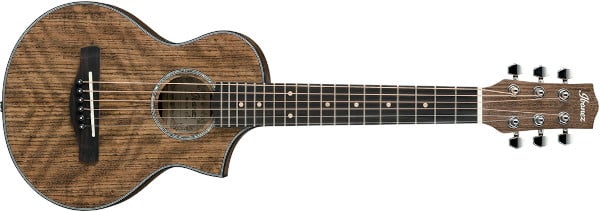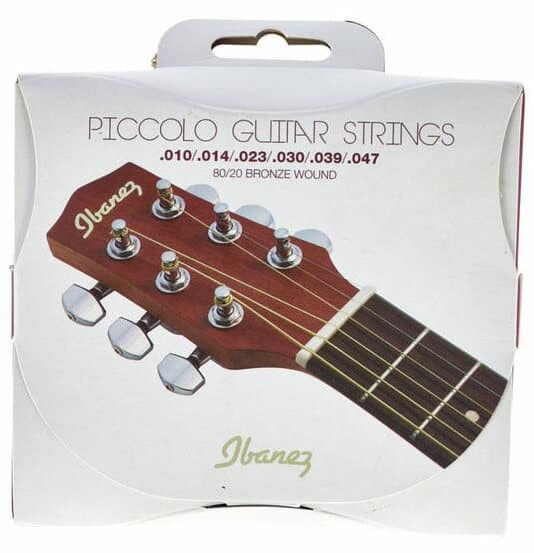Table of Contents
Welcome to the fascinating world of piccolo guitars! These small instruments have a rich history and an original sound that sets them apart from their larger guitar counterparts.
In this Killer Rig article, we will look into the realm of these instruments, exploring their history, anatomy, playing techniques, and more.
If you are wanting to learn more about this captivating instrument, then this guide is the perfect starting point for your piccolo guitar playing future!
What is a Piccolo Guitar?
A piccolo guitar is a smaller version of the standard acoustic. Designed with a compact body and a shorter scale length, this instrument is an appealing option for musicians seeking portability.
The piccolo guitar typically features six strings made of nylon. The strings produce a warm and expressive tone that distinguishes the piccolo guitar from its larger counterparts.
The standard tuning is a perfect fourth higher than a regular guitar, which allows for a broader range of melodies and harmonies.
These guitars are crafted using high-quality tonewoods. Similar to those used in standard instruments.
These materials contribute to the instrument’s bright and resonant sound. Its versatility makes it an excellent choice for both solo performances and ensemble settings.

History of the Piccolo Guitar
The piccolo guitar has a storied past, with origins and development that trace back to the early days of stringed instruments.
Over time, various influential musicians and composers have embraced this smaller guitar. Contributing to its evolution and helping to shape its wonderful sound.
Origins and Development
The piccolo guitar is sometimes referred to as a requinto or terz. It’s a smaller sibling of the standard acoustic guitar.
It originated in the Baroque era, around the 17th century, when luthiers began experimenting with different sizes and tunings for their instruments.
Although the piccolo shares some similarities with other small stringed instruments like the ukulele, it maintains its own characteristics and tuning, which sets it apart.
As string technology improved over the centuries, it evolved, allowing for greater tonal range and playability.
Influential Musicians and Composers
Numerous musicians and composers have contributed to the piccolo guitar’s legacy, exploring its capabilities in various musical contexts.
In the Baroque period, composers like Johann Sebastian Bach and Gaspar Sanz incorporated piccolo guitars into their works, showcasing the instrument’s versatility.
More recently, artists such as Andres Segovia, Narciso Yepes, and Julian Bream have further popularized the instrument, demonstrating its potential in classical and flamenco styles.
Evolution of the Piccolo Guitar Over Time
Throughout its history, the piccolo guitar has undergone several changes in design and construction. Early models featured gut strings, which were later replaced with nylon and steel to improve durability and sound quality.
Modern versions often feature a cutaway design for easier access to higher frets. Some even incorporate electronic pickups for amplification. These innovations have expanded the guitar’s capabilities.
Allowing musicians to explore new genres and techniques while staying true to the instrument’s rich heritage.
Anatomy of a Piccolo Guitar
Now that we know a bit more about where the piccolo guitar originated, let’s learn about its build and how it differs to a standard instrument.
Size and Dimensions
The piccolo is not only smaller, but it’s a higher-pitched variant of the standard guitar. Its compact size, typically ranging between 1/4 and 1/2 of a standard, makes it an appealing choice for those seeking a more portable instrument.
The scale length usually falls between 18 and 21 inches. While the overall length can vary between 30 and 34 inches.
Materials and Construction
Much like their larger counterparts, piccolo guitars are primarily crafted from high-quality tonewoods. This includes spruce or cedar for the top, and mahogany, rosewood, or maple for the back and sides.
These woods are chosen for their specific tonal characteristics, contributing to the bright and expressive sound of the instrument. The neck is typically made from mahogany or maple, while the fingerboard may be crafted from ebony or rosewood.
Strings and Tuning
Piccolo guitars generally have six strings. Although variations with four, five, or eight strings also exist. The strings are made of nylon, giving the instrument its warm tone.
The standard tuning is A-D-G-C-E-A. It’s a perfect fourth higher than a regular guitar. This tuning allows for a more intricate playing style and an extended range, making it a versatile option for various genres.

Comparison to Standard Guitar
In comparison to a standard guitar, the piccolo’s smaller size and special tuning make it a specific instrument with a character all its own.
While the fundamentals of playing are similar, the piccolo’s higher pitch and condensed fret spacing lend themselves to intricate melodies, fingerpicking techniques, and vibrant harmonies.
The piccolo guitar’s clear timbre makes it an excellent choice for solo performances or as an accompaniment to other instruments. Particularly in classical, folk, and world music settings.
Playing Techniques and Styles
The piccolo guitar’s features and tonal characteristics make it suitable for a variety of playing techniques and musical styles.
Here, we’ll explore the specialized methods, genres, and famous players associated with this versatile instrument.
Special Techniques for Piccolo Guitar
Piccolo guitars, with their higher tuning and smaller size, require some adaptations in playing techniques. Especially when compared to standard guitars.
Fingerstyle playing is particularly popular, as the condensed fret spacing and nylon strings allow for intricate fingerpicking patterns and delicate harmonics.
Additionally, styles such as tremolo picking, percussive finger taps, and slurs (hammer-ons and pull-offs) can add depth and expression to performances.
Genres and Styles
The piccolo guitar’s peculiar sound and tuning make it well-suited for a variety of musical genres. It’s commonly found in classical and flamenco music, where its bright, expressive tone complements intricate melodies and complex harmonies.
Additionally, it can be found in folk, Latin, and world music styles. Its portable size and timbre add a particular element to the ensemble.
Famous Piccolo Guitar Players
Throughout history, several renowned musicians have embraced the piccolo guitar, showcasing its potential and versatility.
Some notable players include Pepe Romero, a world-famous classical guitarist known for his expressive playing and mastery of the instrument.
Paco de Lucía, a groundbreaking flamenco guitarist who incorporated the piccolo guitar into his innovative compositions.
Other artists, such as Tommy Emmanuel and Chet Atkins, have also dabbled with the piccolo, further broadening its appeal and influence across genres.
Choosing a Piccolo Guitar
Selecting the perfect piccolo guitar requires careful consideration of various factors, such as your budget, skill level, and intended use.
In this section, we’ll provide guidance on how to make an informed decision when purchasing one, and offer recommendations for top brands and models.
Factors to Consider
- Budget: As with any instrument, the price range for piccolo guitars can vary greatly. With entry-level models starting at around $100 and high-end, custom-built options costing thousands of dollars. Determine your budget beforehand, and remember that investing in a quality guitar can make a significant difference in your playing experience.
- Skill Level: Your proficiency as a guitarist should also influence your choice. Beginners may prefer an affordable, easy-to-play model. While more advanced players might seek a piccolo guitar with superior tonal quality and craftsmanship.
- Intended Use: Consider the primary purpose of your piccolo guitar. If you plan to perform or record, a higher-quality instrument will likely be necessary. However, if it’s intended for casual practice or as a travel companion, a more modest option might suffice.
Top Piccolo Guitar Brands and Models
Several well-known manufacturers produce piccolo guitars. Each offering a blend of quality, playability, and affordability. Some popular brands include:
- Ibanez EWP14WB: This Ibanez piccolo guitar is a popular choice for its compact size, comfortable playability, and affordability. Featuring a cutaway tenor-style body and an open-pore natural finish, the EWP14WB delivers a bright and articulate tone that’s well-suited for fingerstyle playing.
- Bourgeois Victorian Piccolo Parlor: Handcrafted by the esteemed American luthier Dana Bourgeois. The Victorian Piccolo Parlor is a high-end, vintage-inspired instrument. With its smaller parlor-style body, solid wood construction, and exceptional attention to detail. This guitar offers unparalleled tonal richness and projection, making it an excellent choice for serious players and collectors.
Where to Buy or Try Out a Piccolo Guitar
Purchasing a piccolo guitar can be done through various channels, including local music stores, online retailers, and even used instrument marketplaces. Visiting a local music store allows you to test before committing to a purchase.
While online retailers often provide a broader selection and competitive pricing. Additionally, used instruments can offer significant savings, but may require careful inspection for signs of damage or wear.
Tips for Learning to Play the Piccolo Guitar
Learning to play the piccolo guitar can be a rewarding and enjoyable experience. In this section, we’ll cover helpful resources, strategies, and advice for mastering this special instrument.
Online Resources and Tutorials
The internet offers a wealth of information for aspiring piccolo guitar players. Websites such as YouTube and Ultimate Guitar feature video tutorials, lessons, and song tabs specifically designed for all guitarists.
Additionally, online guitar forums and communities can provide valuable support, advice, and inspiration from fellow musicians.
Finding a Teacher or Mentor
One-on-one instruction from an experienced piccolo guitar teacher can significantly enhance your learning process.
A teacher can provide personalized feedback, identify areas for improvement, and help you develop a structured practice routine. To find a suitable instructor, inquire at local music schools, or consult online directories such as TakeLessons and Lessonface.
Practice Tips and Strategies
Consistent practice is essential for developing proficiency on the piccolo guitar. Here are some tips to make the most of your practice sessions:
- Set specific, achievable goals: Establishing clear objectives for each practice session can help you stay focused and track your progress.
- Break down complex pieces: Rather than attempting to play an entire song from start to finish, break it down into smaller sections and practice each part individually before combining them.
- Practice slowly: Playing at a slower tempo allows you to focus on technique and accuracy before gradually increasing the speed.
- Record yourself: Listening to recordings of your playing can help you identify areas that require improvement and track your progress over time.
Conclusion
The piccolo guitar is a fascinating and rewarding instrument with a rich history and a wide range of applications across various genres. Its sound, compact size, and playing techniques make it a captivating choice for musicians of all skill levels.
I encourage you to do more research into the world of piccolo guitars, explore the numerous resources available, and create your own sounds with this remarkable instrument.
FAQs
Is it difficult to transition from a standard guitar to a piccolo?
While the fundamentals of playing the piccolo guitar are similar to those of a standard instrument, the higher pitch, smaller size, and special tuning might require some adjustments.
However, with consistent practice and a willingness to adapt your technique, transitioning between the two instruments can be relatively smooth.
Can piccolo guitars be used in ensembles or bands?
Piccolo guitars can be used in a variety of musical settings, including ensembles and bands. Their sound and tuning can add a special element to a group performance, especially in genres such as classical, folk, or world music.
That being said, the piccolo guitar’s expressive tone and intricate playing techniques also make it an excellent choice for solo performances.
Do I need specific strings for my piccolo guitar?
Piccolo guitars require specific strings due to their unique tuning and smaller scale length. Standard guitar strings will not work properly.
They are not designed for the instrument’s higher pitch and tension requirements. When purchasing strings, ensure they are specifically designed for piccolo guitars to achieve the desired sound and playability.

